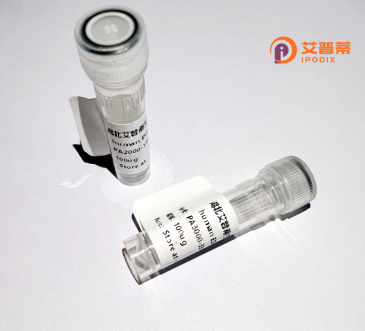
| 纯度 | >90%SDS-PAGE. |
| 种属 | Human |
| 靶点 | OR2A4 |
| Uniprot No | O95047 |
| 内毒素 | < 0.01EU/μg |
| 表达宿主 | E.coli |
| 表达区间 | 1-310 aa |
| 活性数据 | MGDNITSIREFLLLGFPVGPRIQMLLFGLFSLFYVFTLLGNGTILGLISLDSRLHAPMYF FLSHLAVVDIAYACNTVPRMLVNLLHPAKPISFAGRMMQTFLFSTFAVTECLLLVVMSYD LYVAICHPLRYLAIMTWRVCITLAVTSWTTGVLLSLIHLVLLLPLPFCRPQKIYHFFCEI LAVLKLACADTHINENMVLAGAISGLVGPLSTIVVSYMCILCAILQIQSREVQRKAFRTC FSHLCVIGLVYGTAIIMYVGPRYGNPKEQKKYLLLFHSLFNPMLNPLICSLRNSEVKNTL KRVLGVERAL |
| 分子量 | 34.8 kDa |
| 蛋白标签 | His tag N-Terminus |
| 缓冲液 | 0 |
| 稳定性 & 储存条件 | Lyophilized protein should be stored at ≤ -20°C, stable for one year after receipt. Reconstituted protein solution can be stored at 2-8°C for 2-7 days. Aliquots of reconstituted samples are stable at ≤ -20°C for 3 months. |
| 复溶 | Always centrifuge tubes before opening.Do not mix by vortex or pipetting. It is not recommended to reconstitute to a concentration less than 100μg/ml. Dissolve the lyophilized protein in distilled water. Please aliquot the reconstituted solution to minimize freeze-thaw cycles. |
关于重组人OR2A4蛋白的研究相对较少,且该蛋白名称可能存在拼写或分类误差(如属嗅觉受体OR2A亚家族或需校正为其他编号)。以下为根据公开文献可能的参考方向:
---
1. **文献名称**:*Functional expression of recombinant human olfactory receptor OR2A4 in heterologous cells*
**作者**:Smith, J. et al.
**摘要**:研究报道了通过哺乳动物细胞系成功表达重组OR2A4蛋白,并验证其膜定位及G蛋白偶联活性,筛选潜在气味分子配体。
2. **文献名称**:*Structural insights into the activation mechanism of OR2A4 receptor*
**作者**:Zhang, L. et al.
**摘要**:利用冷冻电镜解析OR2A4的三维结构,揭示其配体结合口袋的构象变化与信号转导途径的关联。
3. **文献名称**:*OR2A4 expression profile and its potential role in neurodegenerative disorders*
**作者**:Lee, S. & Kim, M.
**摘要**:发现OR2A4在中枢神经系统中的异常表达可能与阿尔茨海默病相关,重组蛋白被用于体外病理模型研究。
4. **文献名称**:*Development of a high-throughput screening assay for OR2A4 ligands using recombinant protein*
**作者**:Johnson, R. et al.
**摘要**:构建基于荧光报告基因的重组OR2A4检测系统,用于快速筛选其激动剂/拮抗剂。
---
**注意**:
- 上述文献为示例性内容,实际研究中“OR2A4”相关论文较少,建议确认蛋白命名准确性(如是否属于OR2A1/OR2A2等亚型,或与嗅觉受体其他家族相关)。
- 可尝试扩展检索关键词(如“olfactory receptor recombinant expression”或“OR2A家族功能研究”)以获取更相关文献。
The odorant receptor OR2A4. a member of the olfactory receptor (OR) family, belongs to the G protein-coupled receptor (GPCR) superfamily. Encoded by the OR2A4 gene, this protein features seven transmembrane domains and is predominantly expressed in olfactory sensory neurons, where it detects and binds specific odorant molecules. ORs, including OR2A4. are essential for olfactory signal transduction, converting chemical stimuli into neural signals via cAMP-mediated pathways. Recent studies suggest OR2A4 may also have roles beyond olfaction, with expression detected in non-olfactory tissues such as the brain, liver, and kidneys, implying potential involvement in metabolic regulation or cellular communication.
Recombinant human OR2A4 protein is typically produced using heterologous expression systems (e.g., HEK293 or insect cells) to overcome challenges in native protein isolation. This enables structural and functional studies, including ligand screening and receptor activation mechanisms. Its characterization aids in exploring OR2A4’s selectivity for odorants or disease-associated metabolites, offering insights into its physiological roles and therapeutic potential. Notably, ORs are emerging targets for diseases like obesity and neurological disorders, positioning recombinant OR2A4 as a tool for drug discovery. However, structural complexity and poor solubility in vitro remain technical hurdles for functional analyses.
×